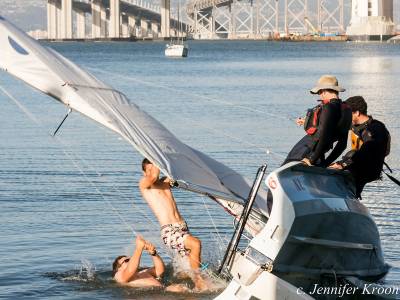Almost all of Cal Sailing's dinghies are equipped with a trapeze kit, and with good reason: our typical stiff summer breezes make it all but a necessity to send someone out on the wire. Having crew out on the wire can be tons of fun for both you and your crew, but can also be quite a challenge. Here are some tips which can help.
Let's assume that you as skipper have two goals:
- Move the boat upwind as quickly as possible.
- Make your crew feel comfortable on the wire.
Now, your crew will probably be most comfortable if the boat is kept relatively flat, sudden changes to heel angle are avoided, and the crew is not required to shift her weight. In other words, she can calmly stand on the rail doing nothing but admiring the view (and calling out gusts and lulls).
On the other hand, in order to make your boat move upwind as quickly as possible, you want to keep the boat flat, and to keep your close-hauled jib at the proper angle of attack to the wind, so that it neither stalls nor luffs.
You, the skipper, have three controls at your disposal: tiller, main sheet, and your body weight. So how do you keep both your crew and the boat happy? Firstly, steer with the tiller to keep the jib at the proper angle to the wind. Secondly, use a combination of body weight and main sheet trim to keep the boat flat. In practice, it is a good idea to hike out moderately and then trim the main accordingly. Indeed, the more you power up the main (while keeping the boat flat), the faster you go. Furthermore, if the wind comes up or down, you still have two controls at your disposal: in a gust, dump the main and hike out hard, and in a lull, sheet in and shift your weight leeward.



